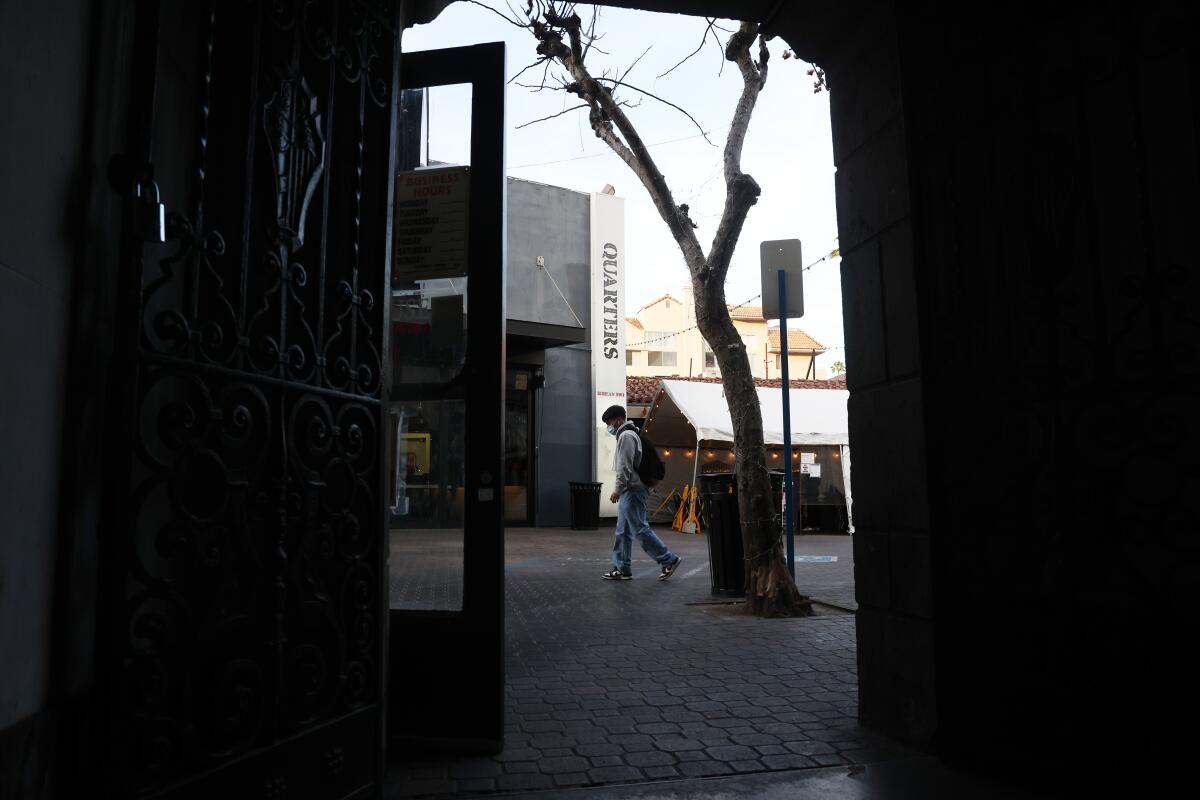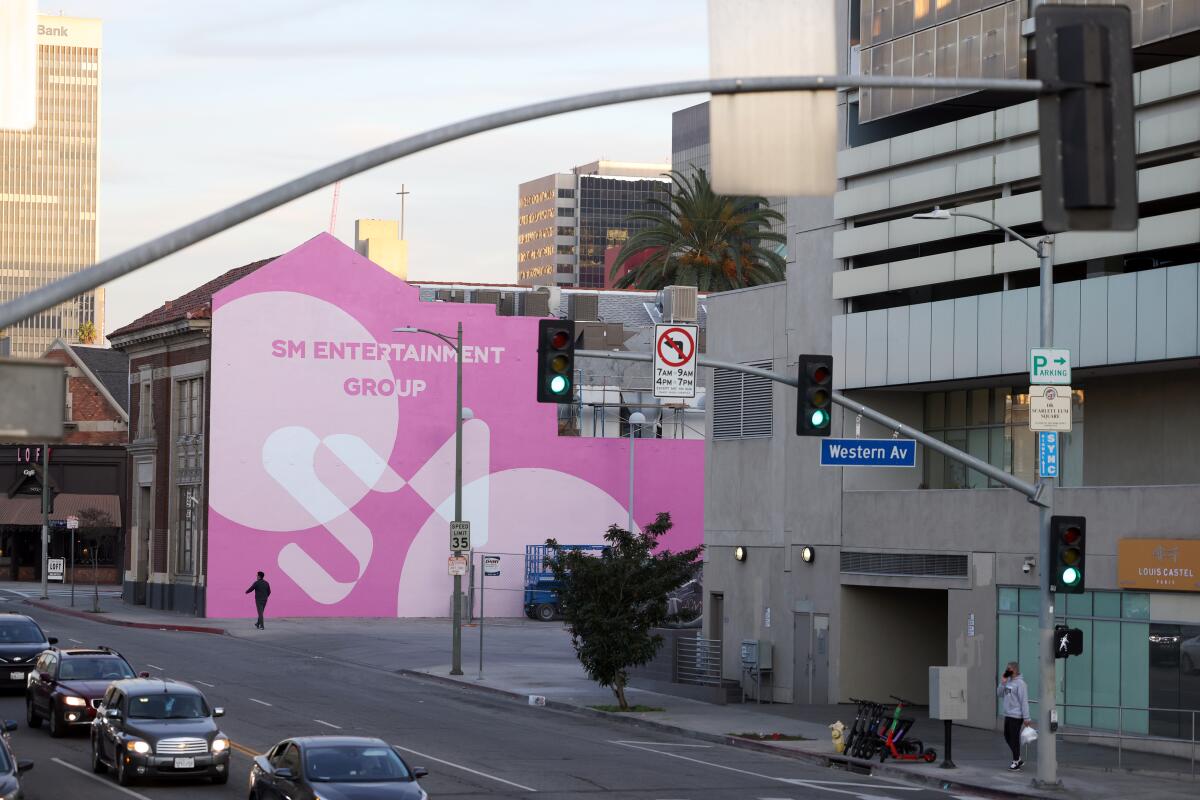A tale of two Koreatowns: Hip spots thrive while older businesses struggle amid Omicron

- Share via
On a recent Friday night, people clustered outside Quarters Korean BBQ, checking their phones or chatting as they braved the hourlong wait.
The restaurant, which occupies a stylish, modern space on 6th Street in Koreatown and serves fusion dishes such as Korean nachos as well as traditional Korean barbecue, is so popular that it has stopped accepting reservations.
An outdoor dining area is a nod to the COVID-19 pandemic. But even the Omicron surge has not diminished the crowds waiting to get in.
Across 6th Street, only a few people were slurping the signature pork neck soup at Yangji Gamjatang.
As Omicron cases accelerated in January, business dropped by 35% at the 33-year-old restaurant.

“Places are quieter,” said owner Ki Young Lee. “People are not coming.”
On the surface, Koreatown’s 6th Street appears to be thriving as the pandemic enters its third year.
Younger customers, many of them non-Korean, crowd trendy restaurants and bars, despite the danger of spreading the highly contagious Omicron variant of the coronavirus. Big brands from South Korea, including a major K-pop company and a well-known Seoul barbecue restaurant, are moving in. Parking remains a blood sport.
On days she drives her car, Elizabeth Bell often pleads to the divine.
But at more traditional Korean restaurants, sharp revenue drops are the norm. Business was just starting to rebound, and then Omicron struck, keeping many older customers at home.

This stretch of 6th Street between Western and Vermont avenues is a microcosm of Koreatown and its dichotomies — old and new, traditional and hip, Korean-speaking and English-speaking.
The pandemic, along with escalating rents and gentrification, has sharpened those differences, leading some to question where Koreatown is headed.
If mom-and-pop restaurants specializing in galbi jjim, kimchi jjigae or soondubu disappear, to be replaced by swankier places or chains like Sweetgreen, will Koreatown lose its soul?
“Right now, there’s sort of a good mixture of both,” said Steve Kang, director of external affairs for the Koreatown Youth and Community Center. “But I would never want the chains to take it over. We would lose our identity here as a community here in Koreatown.”

At 6th Street and Oxford Avenue, a Korean hot dog and fruit juice store offers a “dalgona” challenge. Players try to cleanly chip out a silhouette on a piece of hard honeycomb candy, a la the South Korean show “Squid Game,” which became a global hit on Netflix.
Kitty-corner to the hot dog shop, a poster advertising K-pop idol Max Changmin’s latest album wraps around a building. A major Korean entertainment company has been planning to launch a restaurant here.
This is hip K-Town, where the burgeoning popularity of Korean pop culture, including boy bands to sappy TV series, draws young digital natives eager to sample a taste of Korea in person.
Even with the communal nature of cooking meat around a tabletop grill, some Korean barbecue restaurants, especially those with younger customers and Instagram followings, remain popular.
Mario Toledo, 23, who lives in Koreatown, took a friend visiting from Seattle to Quarters.
“It’s a hot spot. If you go to other places, they’re not doing as well as this place, because this is more trending,” Toledo said while waiting in line for a table.
Anne Laird, 37, from Mid-City, who was also in line at Quarters, said she felt safe eating at the restaurant because the staff was checking vaccination records.
“I’m coming with somebody I trust very much, like a bubble,” she said. “You have to continue to live your life, safely.”

On 6th Street, old Koreatown is also very much on display.
Lee of Yangji Gamjatang is proud that his restaurant has served its fiery red stew with chunks of pork neck floating alongside potatoes and perilla leaves to four visiting South Korean presidents.
For regular customers, the gamjatang is as much comfort food as meatloaf or roast turkey is to others.
Recently, Lee got excited about a party of nine. But he had to turn them away because several didn’t have vaccine cards.
With all the challenges posed by the pandemic, he has been thinking about raising prices. But he fears driving his loyal customers away.
“People are talking about keeping the price the same because people come for that reason,” he said.
Relying on takeout orders, as many restaurants have done in the pandemic, poses a particular challenge for Korean restaurants serving an array of side dishes called banchan.
Cathy Beak, a manager of Mapo Kkak Doo Gee at 6th and Normandie, was busy packing to-go orders on a recent Tuesday afternoon.
She places each order, consisting of many separate boxes, in a large cardboard container — rice, kimchi and other banchan, and main dishes such as braised codfish and grilled mackerel.
Choosing restaurants that have the best banchan is almost as difficult as deciding whose mom makes the best kimchi.
At Kong Ji at 6th and Kenmore, each to-go box costs as much as 40 cents, which adds up, said Ray Kim, manager of the restaurant, which specializes in a deep-fried pork cutlet called donkatsu.

The cost of ingredients is also going up. But raising prices is difficult when customers are already staying away, said Beak of Mapo Kkak Doo Gee.
Before the Omicron surge, customers packed the second floor of Caffe Concerto at 6th and Serrano for corporate events and wedding parties.
Now, the event space is usually empty, said owner Peter Kim. When he emails to confirm a reservation, he often receives a request to cancel.
Kim has increased food prices by 10%, which doesn’t fully make up for a 20% increase in the price of ingredients. Even wine bottles and corks are harder and more expensive to get, he said.
“This is the worst time,” Kim said. “Everything has gone up, but customers went down by half.”
Still, Kim is hopeful that customers will return after Omicron subsides.
At the peak of the pandemic in 2020, the closure of Koreatown institutions Dong Il Jang and Jun Won rocked neighborhood business owners.
The beloved family-run restaurant, open since 1994, will shutter due to the coronavirus pandemic
With the new setback posed by Omicron, Koreatown businesses are “struggling but surviving,” said Peter Il-han Kang, president of the Korean American Chamber of Commerce of Los Angeles.
As Koreatown becomes denser and attracts more non-Koreans, businesses are constantly evolving, making a “better playground” for people to enjoy the culture, Kang said.
“Koreans are good at surviving,” Kang said. “Koreans work the hardest when they are struggling.”

Laura Park’s great-grandfather started a clothing store selling hanbok and other traditional Korean clothing, eventually settling at 6th and Western around 1992.
Park has adapted the family business to the pandemic.
After making masks as a volunteer, she started selling them online, including colorful striped designs evoking Korean children’s dresses called saekdong.

Now, she offers about 500 items online, from wedding dresses to T-shirts inspired by Korean patterns and designs. She has launched a new clothing line for her streetwear and what she calls “everyday hanbok,” turning the poufy high-waisted dress, typically worn on formal occasions, into a daily go-to.
The back of her store is now a photo studio, where people can rent dresses and pose for Instagram selfies.
“If you stay still, you will disappear,” she said. “We cannot just wait for customers, so we went out to find them.”
A few blocks away at 6th and Berendo, Ro Chei and Brian Oh sat down for an early dinner at Seong Buk Dong, which has served Korean dishes such as kimchi jjigae — kimchi stew — and gukbap — beef soup — for nearly two decades.
The business, like many others in K-Town, has been struggling, said owner Young Hee Shon. But decades-long relationships with customers have helped sustain it through the pandemic.
Chei and Oh, both longtime Koreatown residents, have come to Seong Buk Dong for more than a decade for favorites such as galbi jjim — braised beef ribs.
Chei said he finds himself coming again and again because the food reminds him of what his parents made for him when he was growing up.
“This place has been here so long that you gotta support,” said Chei, 30. “It’s my childhood.”
More to Read
Sign up for Essential California
The most important California stories and recommendations in your inbox every morning.
You may occasionally receive promotional content from the Los Angeles Times.















